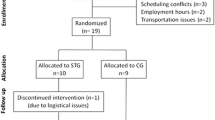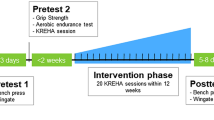Abstract
The aim of the study was to verify whether 8 weeks of resistance training employing maximal isokinetic eccentric (IERT) knee extensor actions would reduce the acute force loss observed after high-intensity treadmill running exercise. It was hypothesized that specific IERT would induce protective effects against muscle fatigue and ultrastructural damages, preventing or reducing the loss in mechanical muscle function after running. Subjects were tested before and after IERT protocol for maximal isometric, concentric and eccentric isokinetic knee extensor strength (60° and 180° s−1). In a second session, subjects performed treadmill running (~35 min) and the previously mentioned measurements were repeated immediately after running. Subsequently, subjects were randomized to training (n = 12) consisting of 24 sessions of maximal IERT knee extensors actions at 180° s−1, or served as controls (n = 8). The effects of acute running-induced fatigue and training on isokinetic and isometric peak torque, and rate of force development (RFD) were investigated. Before IERT, running-induced eccentric torque loss at 180° s−1 was −8 %, and RFD loss was −11 %. Longitudinal IERT led to reduced or absent acute running-induced losses in maximal IERT torque at 180° s−1 (+2 %), being significantly reduced compared to before IERT (p < 0.05), however, RFD loss remained at −11 % (p > 0.05). In conclusion, IERT yields a reduced strength loss after high-intensity running workouts, which may suggest a protective effect against fatigue and/or morphological damages. However, IERT may not avoid reductions in explosive muscle actions. In turn, this may allow more intense training sessions to be performed, facilitating the adaptive response to running training.



Similar content being viewed by others
References
Aagaard P, Simonsen EB, Andersen JL, Magnusson SP, Halkjaer-Kristensen J, Dyhre-Poulsen P (2000) Neural inhibition during maximal eccentric and concentric quadriceps contraction: effects of resistance training. J Appl Physiol 89:2249–2257
Aagaard P, Andersen JL, Dyhre-Poulsen P et al (2001) A mechanism for increased contractile strength of human pennate muscle in response to strength training: changes in muscle architecture. J Physiol (Lond) 534:613–623
Aagaard P, Simonsen EB, Andersen JL, Magnusson P, Dyhre-Poulsen P (2002) Increased rate of force development and neural drive of human skeletal muscle following resistance training. J Appl Physiol 93:1318–1326
Bamman MM, Shipp JR, Jiang J et al (2001) Mechanical load increases muscle IGF-I and androgen receptor mRNA concentrations in humans. Am J Physiol Endocrinol Metab 280:E383–E390
Billat VL, Flechet B, Petit B, Muriaux G, Koralsztein JP (1999) Interval training at V [spacing dot above] O2max: effects on aerobic performance and overtraining markers. Med Sci Sports Exerc 31:156–163
Blazevich AJ, Cannavan D, Coleman DR, Horne S (2007) Influence of concentric and eccentric resistance training on architectural adaptation in human quadriceps muscles. J Appl Physiol 103:1565–1575
Brown SJ, Child RB, Day SH, Donnelly AE (1997) Exercise-induced skeletal muscle damage and adaptation following repeated bouts of eccentric muscle contractions. J Sports Sci 15:215–222
Butterfield TA (2010) Eccentric exercise in vivo: strain-induced muscle damage and adaptation in a stable system. Exerc Sport Sci Rev 38:51–60
Butterfield TA, Leonard TR, Herzog W (2005) Differential serial sarcomere number adaptations in knee extensor muscles of rats is contraction type dependent. J Appl Physiol 99:1352–1358
Crameri R, Aagaard P, Qvortrup K, Langberg H, Olesen J, Kjær M (2007) Myofibre damage in human skeletal muscle: effects of electrical stimulation versus voluntary contraction. J Physiol (Lond) 583:365–380
Dawson B, Henry G, Goodman C et al (2002) Effect of Vitamin C and E supplementation on biochemical and ultrastructural indices of muscle damage after a 21 km run. Int J Sports Med 23:10–15
Denadai BS, Gomide EBG, Greco CC (2005) The relationship between onset of blood lactate accumulation, critical velocity, and maximal lactate steady state in soccer players. J Strength Cond Res 19:364–368
Denadai BS, Corvino RB, Greco CC (2010) Effect of a previous high intensity running exercise on isokinetic muscular strength in individuals with different training backgrounds. Isokinetics Exerc Sci 18:15–21
Farthing JP, Chilibeck PD (2003) The effects of eccentric and concentric training at different velocities on muscle hypertrophy. Eur J Appl Physiol 89:578–586
Gleeson N, Eston R, Marginson V, McHugh M (2003) Effects of prior concentric training on eccentric exercise induced muscle damage. Br J Sports Med 37:119–125
Guglielmo L, Greco C, Denadai B (2009) Effects of strength training on running economy. Int J Sports Med 30:27–32
Higbie EJ, Cureton KJ, Warren GL, Prior BM (1996) Effects of concentric and eccentric training on muscle strength, cross-sectional area, and neural activation. J Appl Physiol 81:2173–2181
Hortobagyi T, Hill JP, Houmard JA, Fraser DD, Lambert NJ, Israel RG (1996) Adaptive responses to muscle lengthening and shortening in humans. J Appl Physiol 80:765–772
Hortobagyi T, Dempsey L, Fraser D et al (2000) Changes in muscle strength, muscle fibre size and myofibrillar gene expression after immobilization and retraining in humans. J Physiol (Lond) 524:293–304
Hortobágyi T, Barrier J, Beard D et al (1996) Greater initial adaptations to submaximal muscle lengthening than maximal shortening. J Appl Physiol 81:1677–1682
Jakobsen MD, Sundstrup E, Randers MB et al (2012) The effect of strength training, recreational soccer and running exercise on stretch–shortening cycle muscle performance during countermovement jumping. Hum Mov Sci 31:970–986
Komi PV (2000) Stretch-shortening cycle: a powerful model to study normal and fatigued muscle. J Biomech 33:1197–1206
Lepers R, Pousson ML, Maffiuletti NA, Martin A, Van Hoecke J (2000) The effects of a prolonged running exercise on strength characteristics. Int J Sports Med 21:275–280
Mackey AL, Brandstetter S, Schjerling P et al (2011) Sequenced response of extracellular matrix de-adhesion and fibrotic regulators after muscle damage is involved in protection against future injury in human skeletal muscle. FASEB J 25:1943–1959
Michaut A, Babault N, Pousson M (2004) Specific effects of eccentric training on muscular fatigability. Int J Sports Med 25:278–283
Nielsen J, Holmberg HC, Schrøder HD, Saltin B, Ørtenblad N (2011) Human skeletal muscle glycogen utilization in exhaustive exercise: role of subcellular localization and fibre type. J Physiol (Lond) 589:2871–2885
Nunes LA, Gandra PG, Alves AA, Kubota LT, Macedo DV (2006) Adequacies of skin puncture for evaluating biochemical and hematological blood parameters in athletes. Clin J Sports Med 16:418–421
Oliveira AS, Caputo F, Gonçalves M, Denadai BS (2009) Heavy-intensity aerobic exercise affects the isokinetic torque and functional but not conventional hamstrings: quadriceps ratios. J Electromyogr Kinesiol 19:1079–1084
Oliveira AS, Corvino RB, Gonçalves M, Caputo F, Denadai BS (2010) Effects of a single habituation session on neuromuscular isokinetic profile at different movement velocities. Eur J Appl Physiol 110:1127–1133
Pensini M, Martin A, Maffiuletti NA (2002) Central versus peripheral adaptations following eccentric resistance training. Int J Sports Med 23:567–574
Proske U, Morgan DL (2001) Muscle damage from eccentric exercise: mechanism, mechanical signs, adaptation and clinical applications. J Physiol (Lond) 537:333–345
Racinais S, Girard O, Micallef JP, Perrey S (2007) Failed excitability of spinal motoneurons induced by prolonged running exercise. J Neurophysiol 97:596–603
Rahnama N, Lees A, Reilly T (2006) Electromyography of selected lower-limb muscles fatigued by exercise at the intensity of soccer match-play. J Electromyogr Kinesiol 16:257–263
Roig M, O’Brien K, Kirk G, Murray R, McKinnon P, Shadgan B, Reid WD (2009) The effects of eccentric versus concentric resistance training on muscle strength and mass in healthy adults: a systematic review with meta-analysis. Br J Sports Med 43:556–568
Santos HH, Ávila MA, Hanashiro DN, Camargo PR, Salvini TF (2010) The effects of knee extensor eccentric training on functional tests in healthy subjects. Braz J Physiother 14:276–283
Thorlund JB, Michalsik LB, Madsen K, Aagaard P (2008) Acute fatigue-induced changes in muscle mechanical properties and neuromuscular activity in elite handball players following a handball match. Scand J Med Sci Sports 18:462–472
Vila-Chã C, Hassanlouei H, Farina D, Falla D (2012) Eccentric exercise and delayed onset muscle soreness of the quadriceps induce adjustments in agonist–antagonist activity, which are dependent on the motor task. Exp Brain Res 212:285–295
Acknowledgments
We would like to thank FAPESP and CNPq for financial support.
Conflict of interest
The authors declare that they have no conflict of interest.
Author information
Authors and Affiliations
Corresponding author
Additional information
Communicated by William J. Kraemer.
Rights and permissions
About this article
Cite this article
Oliveira, A.S., Caputo, F., Aagaard, P. et al. Isokinetic eccentric resistance training prevents loss in mechanical muscle function after running. Eur J Appl Physiol 113, 2301–2311 (2013). https://doi.org/10.1007/s00421-013-2660-5
Received:
Accepted:
Published:
Issue Date:
DOI: https://doi.org/10.1007/s00421-013-2660-5




